Deep Rest: Healing Yoga for Cancer-Related Fatigue
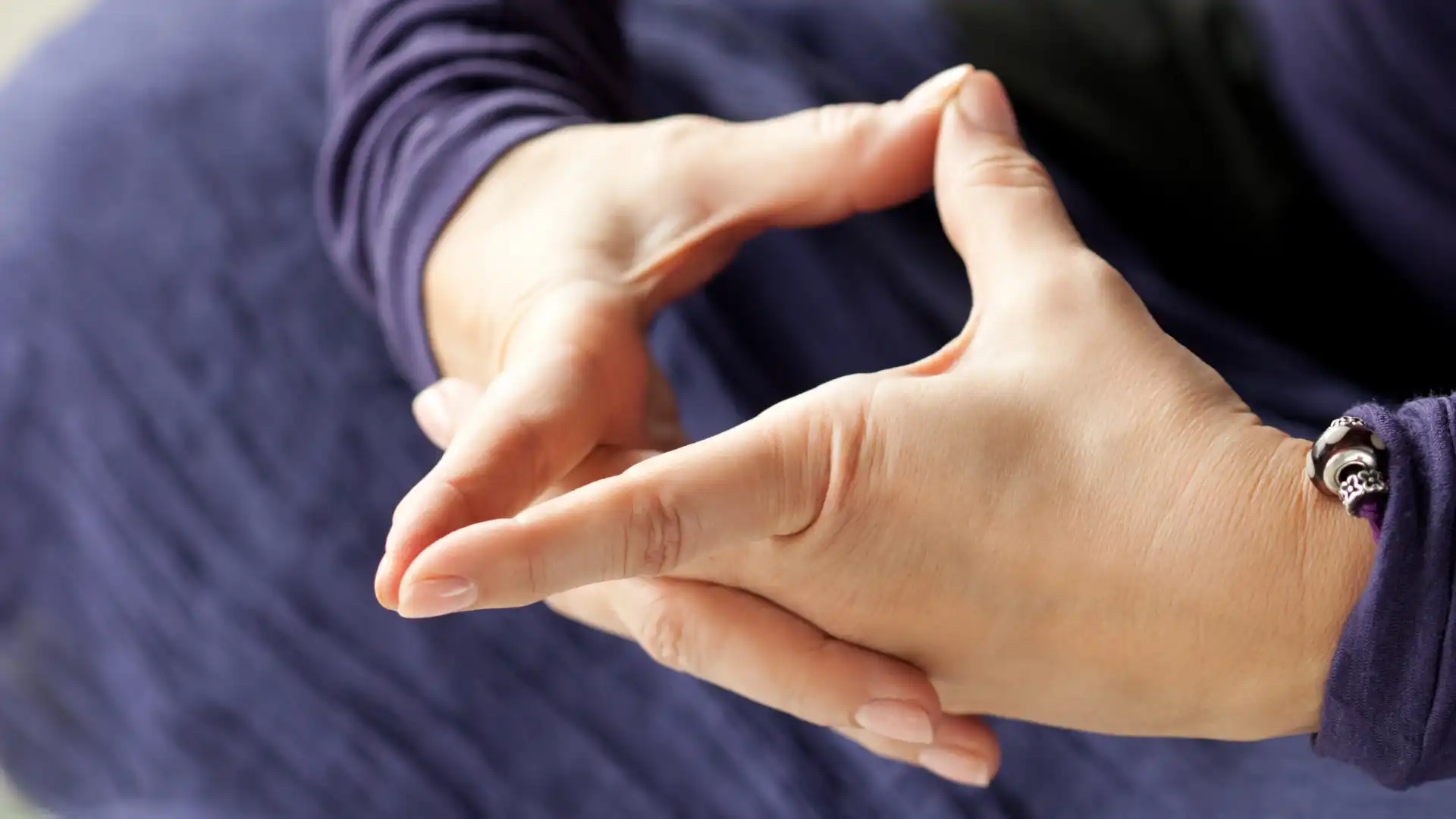
For most people, a good night’s sleep will set us right when we experience occasional fatigue. Cancer-related fatigue is different and not completely understood by allopathic medicine. This deep tiredness is not alleviated by sleeping and is one of the most common, frustrating, and long-lasting side effects for many survivors.
The fatigue may be caused by cancer itself making the body’s processes less efficient and requiring more energy. Chemotherapy and radiation may kill cancer cells, but they also lead to a buildup of cell waste, and extracellular energy is needed to repair damaged tissue. The pain, anxiety, loss of appetite, lack of exercise, insomnia and low blood counts caused by these treatments may also be contributing factors.
Yoga for Cancer-Related Fatigue
Yoga offers powerful tools that help to relieve cancer-related fatigue such as asana (postures), mudra (hand gestures), pranayama (conscious breath), and relaxation. A recent literature review showed that yoga can improve the quality of life by increasing both physical and mental energy. The yoga practice that follows is a combination of gently stimulating mudra, movement, and pranayama, followed by a restorative inversion which provides a few moments of rest. Practice at any time of the day, all or in part.
Yoga Practice Tips
-
Do a little yoga each day to give yourself the time and space to heal. Make yoga a permanent part of your life after cancer.
-
Stay mindful of the body and breath throughout the practice. Only move in a comfortable range of motion. If you become uncomfortable, dizzy, nauseated or breathless, stop immediately and rest for a few moments.
-
For this practice, a yoga mat and two soft props (bolsters, blankets or pillows) will be helpful.
Stating Intention with Uttarabodhi Mudra
Stating an intention, or sankalpa, is an important first step toward using yoga as a healing practice. Combined with a mudra that is stimulating to the immune system, it can serve as a reminder of your goals during this time.
-
Begin sitting in a comfortable seated position with your hands clasped together.
-
Extend your index fingers and thumbs away from each other to create a diamond shape. Keep the center of your palms open.
-
First place your hands in front of your belly with your thumbs resting at your navel, pinkies resting toward your pubic bone. This placement of your hands creates a sense of self-nurturance. Notice the physical and energetic effect of this gesture.
-
Next, try a more stimulating version of Uttarabodhi Mudra by rotating your hands so that they rest in front of your sternum with your index fingers pointing toward your throat (as shown).
-
Can you feel a difference holding the mudra here?
-
While holding Uttarabodhi Mudra state your sankalpa three times silently. If you have difficulty formulating an intention, use the statement, “I am energized and alive.”
-
Hold the mudra for a few more breaths, then release your hands.
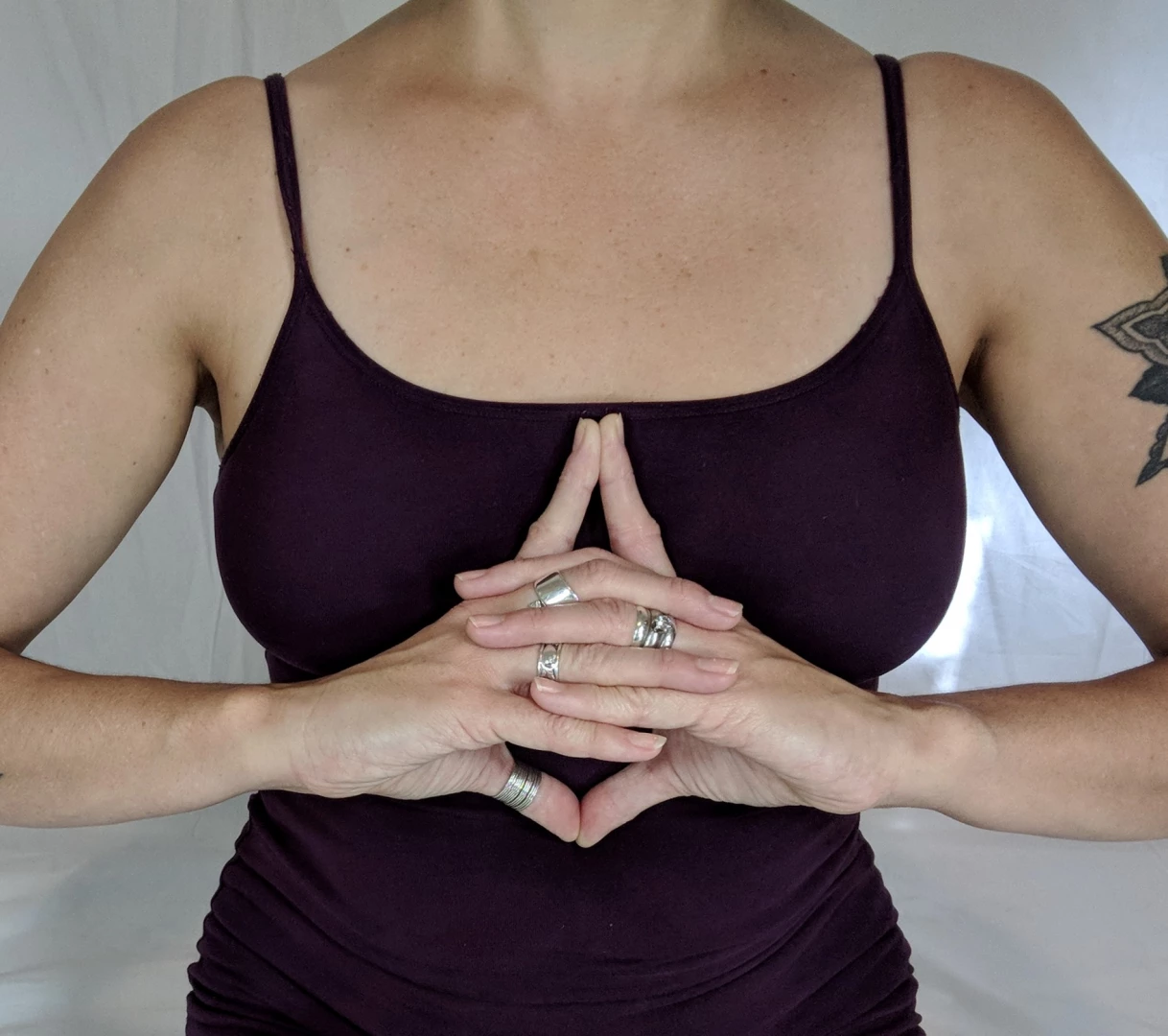
Seated Trio
Cancer-related fatigue often creates such tiredness that movement of the body seems like a challenge. When we are sedentary, our energy becomes stagnant and prana cannot flow to the areas of the body where it is needed to keep us healthy. Movement is a simple way to allow both prana and lymph to flow.
The lymphatic system is key to immunity and relies on the pumping of muscles to move lymph through the nodes and vessels. It is especially important for breast cancer patients to move the arms and upper chest; this trio of seated spinal movements moves prana and lymph into the armpit area and increases the range of motion in the spine and shoulders.
When moving your arms, it is important to only stretch to a comfortable degree, especially if there are surgery sites or ports in the chest. Alternate arm positions will be given, so be sure to choose what is comfortable. Continue to follow the pace of your breath, it is a barometer of how you are feeling in each pose. If you find yourself holding the breath or feeling discomfort, try again a bit more gently.
Seated Lateral Bend:
-
Begin in a comfortable cross-legged position, sit in a chair if desired.
-
Reach the crown of your head towards the ceiling.
-
As you inhale side bend to the right bringing your left hand to your right shoulder, behind your head (as shown), or reach the left arm overhead with the palm facing inward.
-
Rest your right hand on the floor with your elbow bent.
-
Keep both sit bones grounded into the floor.
-
Exhale and return to center, then repeat to the left side. Alternate sides for 5 repetitions following your breath.
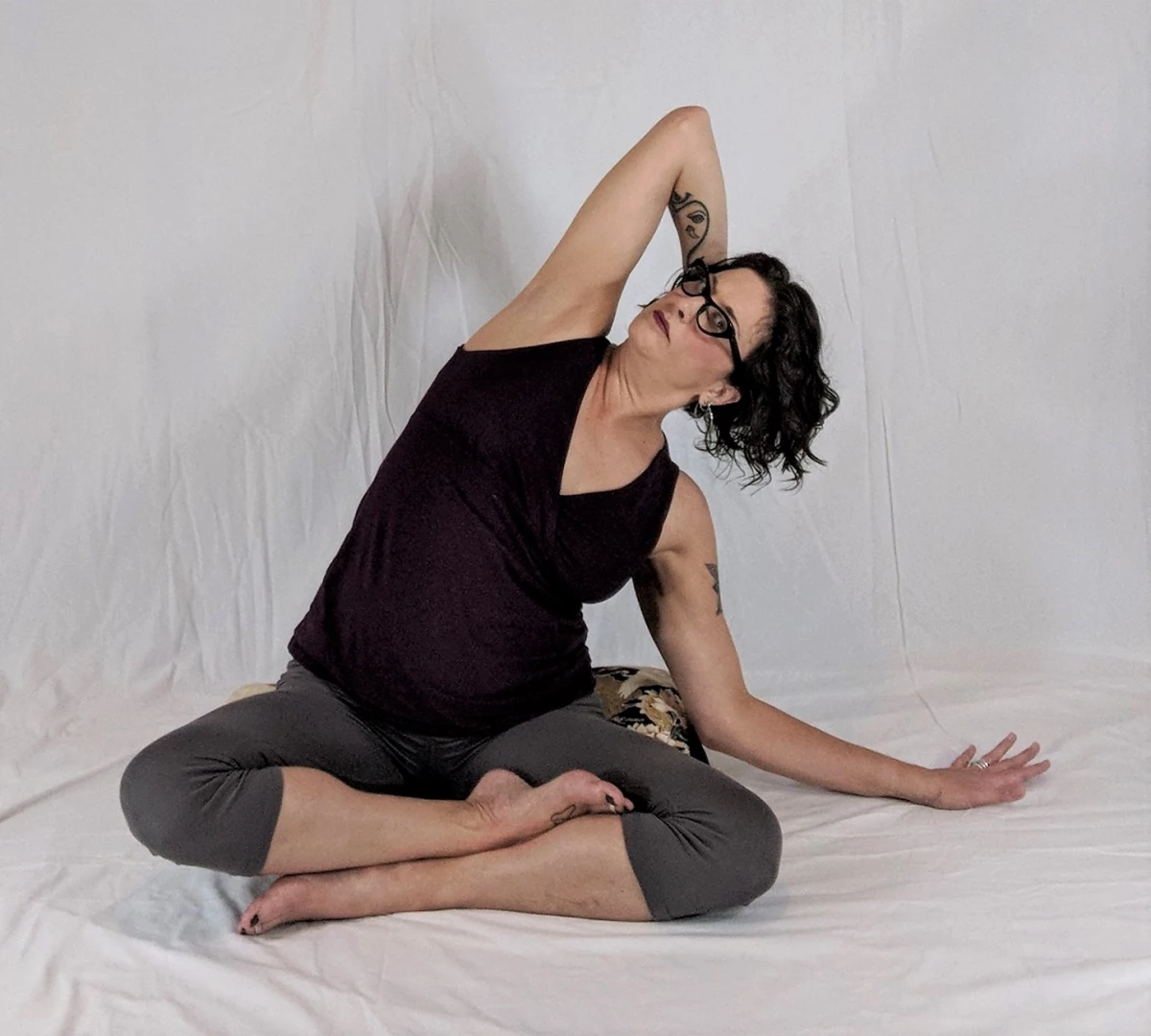
Seated Twist:
-
As you inhale create length in the sides of the torso by bringing both hands together at your heart, placing your hands on the top of your head, or raising both arms overhead.
-
Exhale and twist your belly, ribs, and then your chest, to the right.
-
Place your left hand to your right knee and your right hand on the floor behind you.
-
Inhale and return to the center with your arms in your chosen position.
-
Exhale and repeat to the left. Repeat to both sides with the breath 5 times.
Seated Forward Fold:
-
Inhale and lengthen from your pubic bone towards the crown of your head bringing both hands together at your heart, placing your hands on the top of your head, or raising both arms overhead.
-
As you exhale lean your torso forward, resting your palms or your forearms on the floor.
-
Hold for at least 5 breaths, then on an exhalation, engage your belly and press your torso back up to center.
-
You might try this again with your legs crossed in your non-habitual position.
Reclining Heart Opener
A gentle backbend is helpful for increasing breathing capacity as well as uplifting your mood, as it enables deeper inhalations throughout the upper chest.
-
Recline the middle back over a bolster or rolled up blanket. Place a second folded blanket under your head with space between the two props for your upper back and shoulders to rest on the floor.
-
If this is difficult, place more support under your head, or add support under your hips as well.
-
You may extend the legs as shown, or rest here with your knees bent for up to 5 minutes.
-
Breathe into your upper chest and keep relaxing your head, neck, and shoulders into the supports.
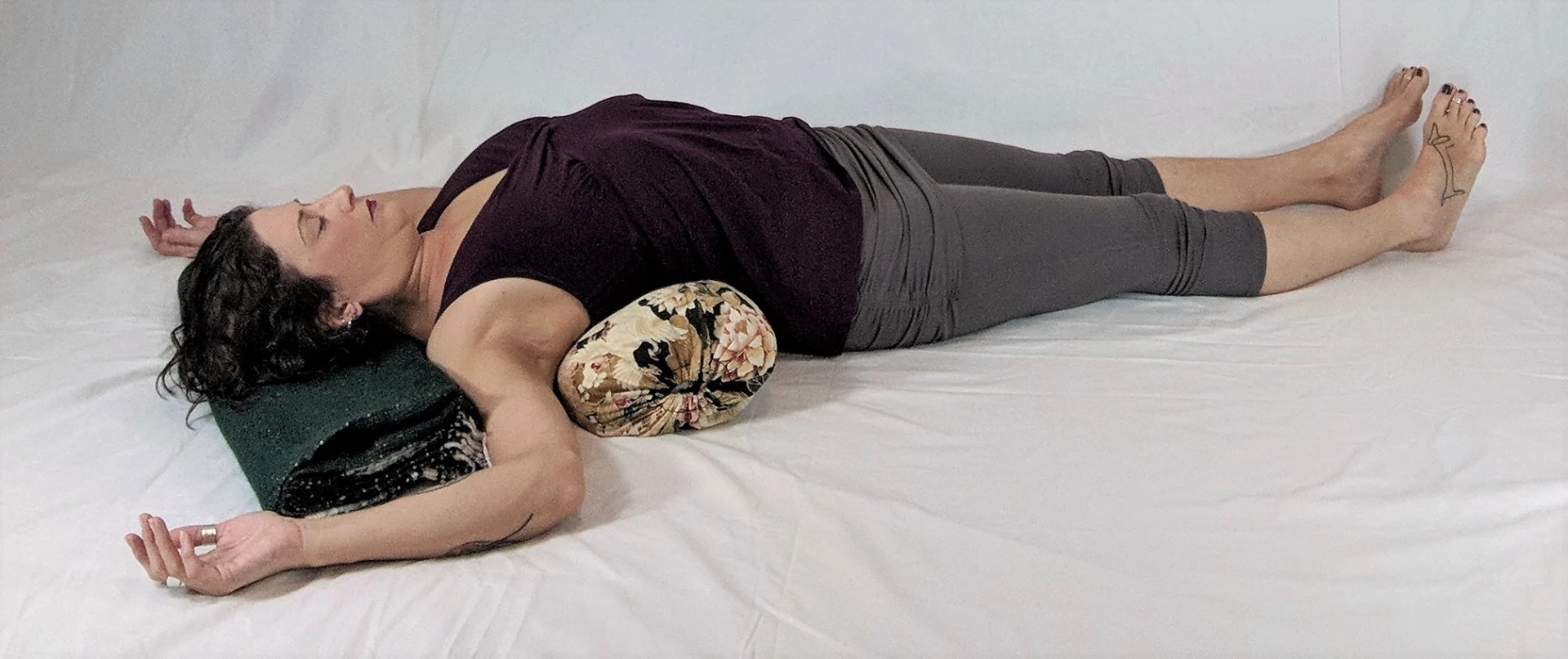
Anuloma Krama (3-Part Inhalation)
Practicing pranayama can have a profound effect on your energy levels and mood. Focusing on the inhalation tends to increase energy and lighten the mood. You can practice the three-part inhale from the reclined heart opener described above, or rest on the back with the knees bent and the feet on the floor.
-
Begin by noticing your natural breath. How does it feel moving in through the nose? How does it feel moving out through the nose?
-
Can you slowly begin to separate your inhalation into three short “sips” of breath through the nose? Make sure you get a full inhalation but try not to over breathe.
-
Allow the exhalation to be soft and easy. Notice the effects of this breath as you continue for a few minutes.
-
When you are finished, spend a few moments relaxing the breath back to its normal everyday pattern.
Legs on a Chair
Restorative yoga can complete a yoga practice or be done by itself on days when you are highly fatigued and need to reset your body and mind. This posture is a mild inversion that provides a change in your perspective to gravity and encourages deeper breathing, energy absorption, and relaxation.
Elevating your legs on the chair helps with fatigue in several ways. Besides allowing the body to be still for a few minutes, this pose allows the venous blood to flow back up the legs toward the heart where it is better circulated. This process sends signals to the parasympathetic nervous system to turn on the “relaxation response.” It does take some time for these internal processes to occur, so rest here for as long as you feel comfortable.
-
Find a piece of furniture in your home such as a soft chair, sofa seat or ottoman that you can use for support.
-
Recline in front of your furniture support and place your calves on the seat, supporting your head with a folded blanket or pillow if needed.
-
Completely relax your legs and rest your arms slightly away from your sides with the palms facing up.
-
Rest here for at least 10 minutes. Feel free to set a timer if you are concerned that you might fall asleep.
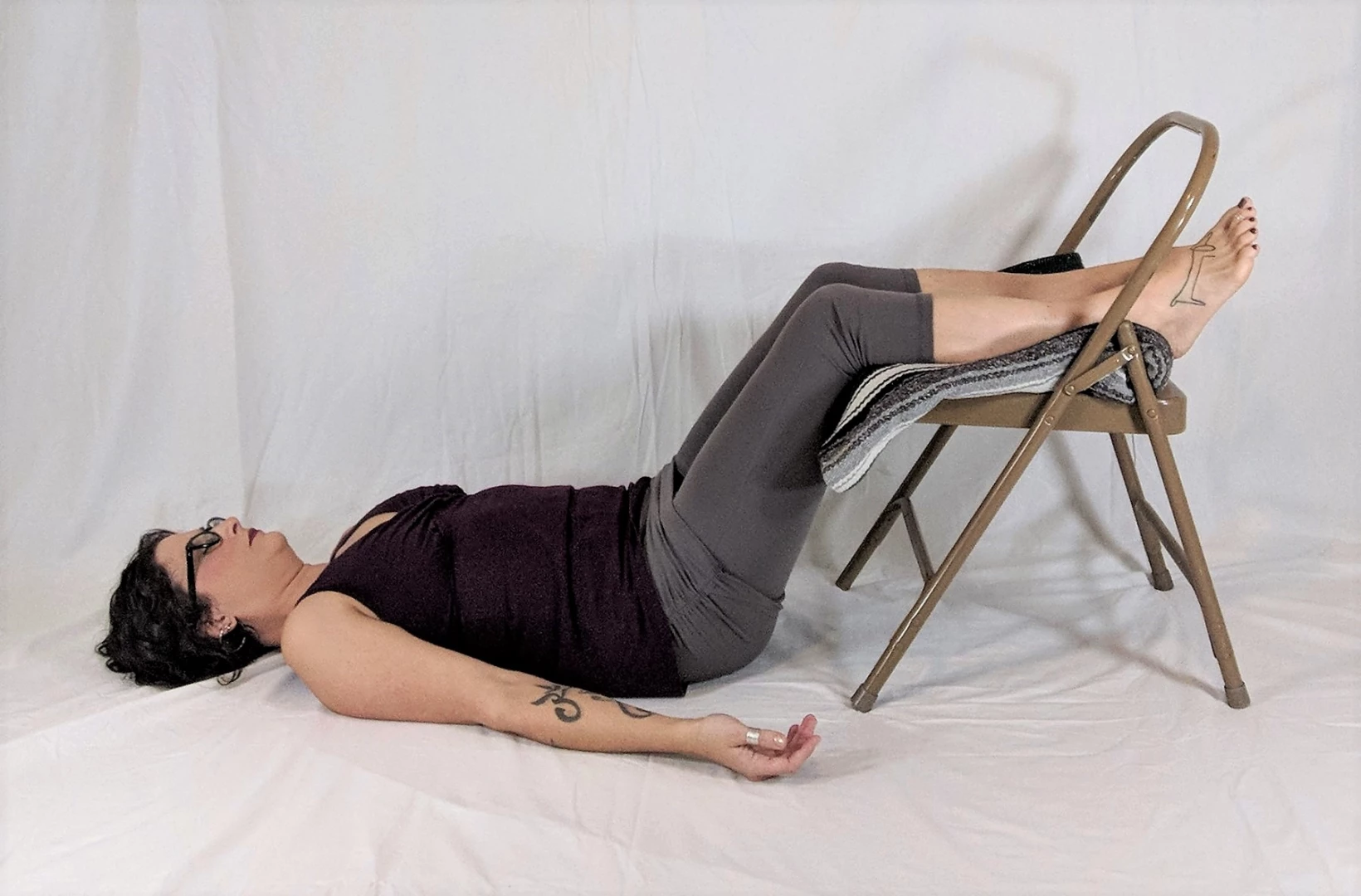
When you are ready to return to your day, take your time rolling over onto your favorite side, resting there for a few moments while you repeat your sankalpa from the beginning of the practice. Then use the strength of your arms to press yourself back up to a seated position.
Study more about this topic with YogaUOnline and Tari Prinster – Introduction to Yoga for Cancer: Tapping Into the Body’s Inherit Healing Wisdom.
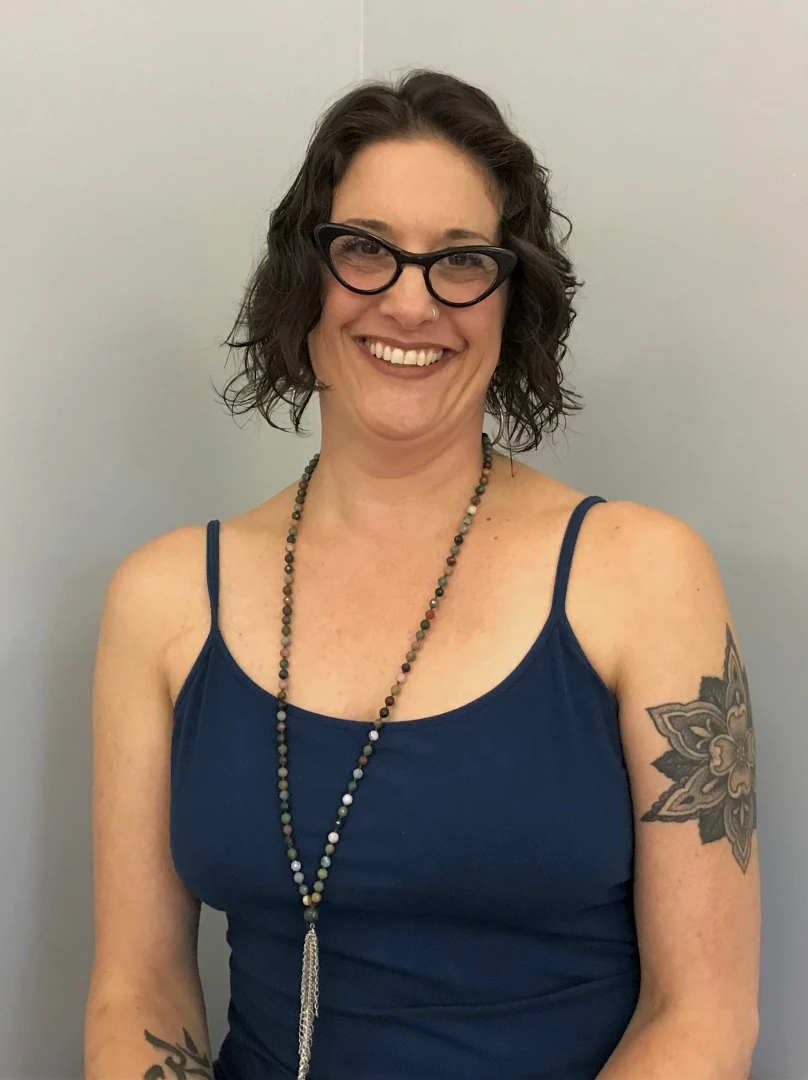 Cheryl Fenner Brown, C-IAYT, ERYT 500 works with cancer patients and people over 50 in central North Carolina. Her 700-hr Hatha training at Piedmont Yoga Studio and 1000-hr Integrative Yoga Therapy training inform her unique blend of alignment principles with subtle energy work, sound, mudra, and yoga nidra. She teaches classes, privates, self-care retreats and enjoys mentoring teachers in a 100-hr Adaptive Yoga Mentorship. Her Healing Yoga for Cancer Survivorship DVD is based on her feasibility study presented at IAYT’s Symposium on Yoga Research and the Society of Integrative Oncology’s annual conferences in 2015 and highlighted in Yoga Journal. From this work she developed a 50-hr Healing Yoga for Cancer teacher training that is offered nationwide, find out more at www.yogacheryl.com.
Cheryl Fenner Brown, C-IAYT, ERYT 500 works with cancer patients and people over 50 in central North Carolina. Her 700-hr Hatha training at Piedmont Yoga Studio and 1000-hr Integrative Yoga Therapy training inform her unique blend of alignment principles with subtle energy work, sound, mudra, and yoga nidra. She teaches classes, privates, self-care retreats and enjoys mentoring teachers in a 100-hr Adaptive Yoga Mentorship. Her Healing Yoga for Cancer Survivorship DVD is based on her feasibility study presented at IAYT’s Symposium on Yoga Research and the Society of Integrative Oncology’s annual conferences in 2015 and highlighted in Yoga Journal. From this work she developed a 50-hr Healing Yoga for Cancer teacher training that is offered nationwide, find out more at www.yogacheryl.com.
References
American Cancer Society (2016). “What Causes Cancer-related Fatigue?” Retrieved from https://www.cancer.org/treatment/treatments-and-side-effects/physical-side-effects/fatigue/what-causes-cancer-related-fatigue.html
Cancer Research UK (2018). “Causes of Fatigue” Retrieved from https://www.cancerresearchuk.org/about-cancer/coping/physically/fatigue/causes
Sadja, J., & Mills, P. J. (2013). Effects of Yoga Interventions on Fatigue in Cancer Patients and Survivors: A Systematic Review of Randomized Controlled Trials. Explore (New York, N.Y.), 9(4), 232–243. http://doi.org/10.1016/j.explore.2013.04.005



